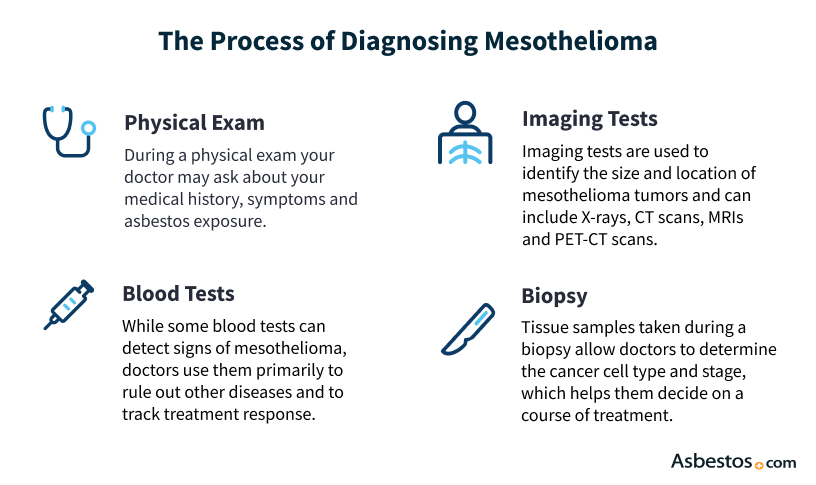Mesothelioma Diagnosis
Diagnosing mesothelioma can be challenging because signs of the disease are similar to other conditions. Imaging and blood tests, as well as physical exams, are helpful tests for mesothelioma, providing key information. A biopsy and pathology report can confirm your mesothelioma diagnosis.

Expert Take
Dr. David Sugarbaker: How Is Mesothelioma Diagnosed?
So what we need to do, as clinicians, is find out what's causing that thickening. And therefore, the first approach is usually to tap away that fluid and have it sent off for cytology to see if there's any evidence of malignant cells within that pool of fluid that is gathered in the patient's chest.
Unfortunately, for the majority of patients, when you tap off this fluid and send it off to cytology, the results are negative. And I would caution patients to accept a negative report of that cytology, because for most patients, there can very well be cancer there, even though the cytology is negative. And therefore, a biopsy is the most definitive way in which patients will understand clearly that they either have or don't have mesothelioma.

Expert Take
Dr. David Sugarbaker: How Is Mesothelioma Diagnosed?
So what we need to do, as clinicians, is find out what's causing that thickening. And therefore, the first approach is usually to tap away that fluid and have it sent off for cytology to see if there's any evidence of malignant cells within that pool of fluid that is gathered in the patient's chest.
Unfortunately, for the majority of patients, when you tap off this fluid and send it off to cytology, the results are negative. And I would caution patients to accept a negative report of that cytology, because for most patients, there can very well be cancer there, even though the cytology is negative. And therefore, a biopsy is the most definitive way in which patients will understand clearly that they either have or don't have mesothelioma.
How Is Mesothelioma Diagnosed?
Mesothelioma diagnosis may involve a combination of tests, including a physical exam, imaging tests, fluid analysis and biopsies to confirm this rare cancer. Mesothelioma tests depend on your symptoms and where your tumor is located.
Diagnosing mesothelioma can be challenging because signs of the disease are similar to other conditions. If you and your doctor have discussed your history of asbestos exposure and symptoms, they may suspect mesothelioma.
Key Tests to Diagnose Mesothelioma
- Biopsies: Common procedures for collecting tissue or tumor samples include core needle biopsy, thoracoscopy with VATS, laparoscopy and mediastinoscopy.
- Blood tests: They can show unusual blood cell counts and some markers for mesothelioma but can’t detect mesothelioma cancer cells.
- Fluid analysis: Fluid is removed in procedures like thoracentesis and paracentesis. Analysis of cells in this fluid can help diagnose mesothelioma.
- Imaging tests: Seeing tumor size, location and spread on PET scans, X-rays, CT scans and MRIs can help identify the stage of cancer progression.
- Medical history and physical exam: Discuss your complete history with your doctor who will perform a physical exam to identify signs of mesothelioma.
Learn about your diagnosis, top doctors and how to pay for treatment in our free mesothelioma guide.
Get Your GuideYour doctor may refer you to an oncologist for further tests for mesothelioma. Your oncologist will listen for sounds indicating fluid buildup, a common sign of mesothelioma. Then, you’ll likely have imaging tests to identify where tumors are located and how far they’ve spread, a process known as staging the disease.
A biopsy is the most important test in confirming a mesothelioma diagnosis. A pathologist will use a microscope to study the tissue or tumor sample collected during your biopsy and write up their findings. Pathology reports show the specific type of mesothelioma cells in your sample. The type of mesothelioma cell can affect your prognosis and treatment plan.

Medical History and Physical Exam
If you have chest pain, trouble swallowing, shortness of breath or back pain and you were exposed to asbestos, see your doctor. First, your doctor will discuss your medical history and ask about asbestos exposure.
Then, your doctor will do a physical exam, checking for symptoms of mesothelioma, such as fluid buildup in your chest (pleural effusion) or in your belly (ascites). They’ll check for fluid around your heart (pericardial effusion). In rare cases of testicular mesothelioma, they’ll perform a physical examination of the groin area.

“After reading the guide, I felt more confident about what was ahead.” – Carla F., mesothelioma survivor
Get Your Free GuideImaging Tests for Mesothelioma
Radiologists use mesothelioma imaging tests, including PET scans, X-rays, echocardiograms, CT scans and MRIs, to locate and assess mesothelioma tumors. Some scans involve contrast dye. Most scans are generally quick and painless. MRIs can take 30 to 90 minutes.
Types of Mesothelioma Imaging Scans
- Computed tomography scans: CT scans produce high-resolution cross-sections with detailed views of possible tumors in the chest and abdomen.
- Echocardiograms: A noninvasive procedure, echocardiograms use ultrasound to create an outline of the movement of the heart.
- Magnetic resonance imaging scans: MRIs use a strong magnetic field and radio waves to form detailed images of the person’s soft tissues.
- Positron emission tomography scans: PET scans use an injected radioactive tracer to find cancer cells. PET/CT scans combine both as a more comprehensive tool.
- X-rays: These are most likely the first imaging test done. X-rays can identify pleural or peritoneal tumors. X-rays only provide a 2D view.
Doctors use imaging scans to see signs of asbestos exposure. They look for hardened areas on the lung lining called pleural plaques. These signs and other tests help doctors see if an asbestos-related disease is present.
Some scans such as MRIs may cause anxiety in some patients. Health care providers may prescribe anti-anxiety medications. These drugs help patients relax during the scan.
The day I found out I was diagnosed with mesothelioma, I was pretty scared. I was shocked. I was in shock. I felt like I was in the Twilight Zone. When they told me I was diagnosed with mesothelioma, no one knew what it was. I didn’t know what it was. My mom, my husband, no one. It was the day my whole life changed.
Blood Tests
Doctors sometimes order blood tests to help check for mesothelioma. These tests look for certain proteins, white blood cell levels and other possible signs called biomarkers. However, these blood markers aren’t only found in people diagnosed with mesothelioma. Doctors use blood tests like MESOMARK, N-ERC/mesothelin and fibulin-3 blood tests to get clues, but they need a biopsy to confirm a mesothelioma diagnosis. Blood tests alone can’t diagnose mesothelioma.
Fibulin-3 is a protein your body makes to help build and support connective tissues. Mesothelioma cells can release extra fibulin-3, which leads to higher levels in the blood. But higher levels can also show up with other cancers like cervical cancer. Similarly, the MESOMARK blood test looks for molecules called soluble mesothelin-related peptides. Mesothelioma cells make SMRPs. But SMRPs have also been found in ovarian and pancreatic cancer.
Researchers are studying new types of tests. In 2025, the American Society of Clinical Oncology started to recommend genetic testing. Genetic testing often involves blood and saliva tests. A 2024 review reports up to 10% of patients diagnosed with mesothelioma have what’s known as a BAP1 mutation. They tend to respond better to chemotherapy. Patients with this mutation have a median survival of 5 years.
Fluid Analysis (Cytology Tests)
Mesothelioma cytology tests help doctors find cancer cells in fluid. Doctors collect samples from effusions or ascites from the chest, abdomen or around the heart. Then, they use a microscope to search for mesothelioma cells. If they find these cells, it helps them diagnose mesothelioma.
Types of Mesothelioma Cytology Tests
- Paracentesis: Doctors insert a needle into your belly to remove fluids for testing. This test is common for people with peritoneal mesothelioma.
- Pericardiocentesis: A needle is inserted into your chest to remove fluid from around your heart. This test is common for those with pericardial mesothelioma.
- Thoracentesis: Doctors insert a needle into your chest. This procedure is common for people with pleural mesothelioma.
Both cytology tests and biopsies help diagnose mesothelioma, according to a 2024 study published in the Journal of the American Society of Cytopathology. The key difference between the two tests is cytology tests look at fluid, while biopsies take tissue samples. Biopsies give more information about cancer cells, which is how doctors determine whether you have mesothelioma.
Biopsies
A biopsy is the best test for confirming a mesothelioma diagnosis. This medical procedure takes a sample of tissue that’s studied under a microscope to check for cancer cells. Doctors suggest a biopsy if you show signs of mesothelioma. Imaging scans, such as CT or PET scans, help guide where the sample should be taken from and assess cancer spread.
Types of Mesothelioma Biopsies
- Laparoscopy: Doctors make a small cut in the abdomen and use a tiny camera and tools to take a tissue sample. This type of endoscopic biopsy is best for peritoneal mesothelioma.
- Mediastinoscopy: A small cut is made above your breastbone, then doctors use a tube with a light to see and take tissue. This is for biopsies of the lymph nodes and around the windpipe for pleural mesothelioma.
- Core needle biopsy: A thin needle is put through your skin to take a small piece of tissue. Also known as a fine-needle aspiration, it’s used for tissue samples that are hard to collect.
- Surgical biopsy: Surgeons make a larger cut to remove a tissue sample when other methods don’t work. This is used when an endoscopic or core needle biopsy isn’t possible.
- Thoracoscopy: Doctors make a small cut in the chest, then use a tube with a camera to look and take tissue. This is the most accurate biopsy for diagnosing pleural mesothelioma.
Thoracic surgeon Dr. Jeffrey Velotta tells us, “The diagnosis of mesothelioma is very difficult. Fluid, the majority of the time, 70% to 80% of the time will not tell you if you have mesothelioma or not. There’s just not enough cells in the fluid. You actually need tissue. I recommend all patients undergo biopsy as soon as possible and not wait.”
Staging Mesothelioma Cancer
Mesothelioma staging is part of the diagnostic process. It describes how far tumors have spread, which can be seen on imaging scans. The 4 stages of mesothelioma range from early stage (stages 1 and 2) to late stage (stages 3 and 4). The higher the number, the more the cancer has spread from where it started.
Staging helps doctors plan the best treatment. An early-stage diagnosis improves treatment options. A late diagnosis makes these treatments less effective. Later stages become more difficult to treat.
The TNM staging system is the official system doctors use to stage pleural mesothelioma. It identifies tumor size and location, and whether cancer cells have entered lymph nodes or metastasized. Doctors use a modified TNM system for peritoneal mesothelioma. There is no official staging system for pericardial or testicular types.
Thoracic Surgeon and Director of the New York Mesothelioma Program at Mount Sinai Dr. Andrea Wolf, tells us, “When staging mesothelioma, I assess where the cancer is located, how far it has spread, and which organs are involved. This information is essential in developing the most effective treatment plan for each of my patients.”
| Stage at Diagnosis | % of Respondents |
|---|---|
| Stage 1 | 12% |
| Stage 2 | 17% |
| Stage 3 | 23% |
| Stage 4 | 48% |
Why Is Diagnosing Mesothelioma Difficult?
Diagnosing mesothelioma is difficult because its symptoms mimic more common illnesses like bronchitis or pneumonia. The latency period between asbestos exposure and mesothelioma can be 20 to 60 years. So when symptoms show up decades later, an asbestos-related disease like mesothelioma may not immediately come to mind.
Mesothelioma misdiagnosis is unfortunately common, especially with doctors unfamiliar with this rare malignant cancer. This makes getting a second opinion from an asbestos-related cancer expert so important if you’ve had a history of asbestos exposure. But some people aren’t aware they’ve been exposed, making it even more challenging.
Patient Advocate and VA-accredited claims agent Danielle DiPietro tells us, “Many patients we speak with have told us they were diagnosed after going to the hospital for what they thought was an unrelated symptom.”
Mesothelioma survivor Wendy M. Phillips confirms this was the case for her. She tells us, “I went to the hospital with a swollen arm and was initially told I had a blood clot. Mesothelioma tumors were blocking my lymph nodes.”
Importance of Early Mesothelioma Detection
Finding mesothelioma early is very important because it allows doctors to start treatment sooner. An early diagnosis and guidance from a mesothelioma specialist can offer more treatment options and better outcomes. This can improve survival and quality of life.
However, according to the Centers for Disease Control and Prevention, early detection is still rare. From 2017 to 2021, 70.9% of mesothelioma cases were diagnosed after stage 1.
And I had this sharp shooting pain on the left side.
My husband jumped out of bed. He’s like, “what’s wrong?” I said, I think I’m having a kidney stone. And he’s like, alright. Let’s go to the emergency department.
I’m not one to go see doctors, and and I think really I hadn’t been to emergency department in probably 15 years or so. So we ended up there, and they said, “well, you must have passed it because we don’t we don’t see we don’t that we don’t see anything.” I was okay for probably three or four months, and then it came again.
Not to the same degree. And I was kinda like, “Oh, oh, ow, ow!” and it kept happening. And the intervals were coming closer, than than before. They weren’t as spread out.
And so my PCP finally said, “Kim,
let’s let’s just, let’s just get a a cat scan. Okay?”
And I said, “oh, okay.” And the CAT scan came back. And he said, there’s something see some sort of nodule, that’s what he called it, a nodule at the base of your left lung. It’s not your kidney. It’s the bottom of your left lung. Which is right about where your kidneys are. And I thought, oh my gosh, I never never thought it would be like a lung thing.
So, I said, oh, okay.
And he said, let’s watch it. Because it’s so small right now.
And I said, alright. I’m good with that. But then the pain kept happening. And he said, I’m gonna refer you to a pulmonologist.
And I saw the pulmonologist, And he said, he said, I don’t know Kim. The only thing I can think is you let’s biopsy it. It’s it’s something there. It’s some sort of mask. You keep having pain.
I didn’t have the I didn’t have any problems with shortness of breath. I didn’t have, coughing, excessive coughing.
It was mainly the pain. He said, we just need to biopsy it.
So I said, alright. That sounds great.
Pleural mesothelioma survivor Kevin Hession is an unusual example of someone diagnosed early. He tells us, “After my surgery, I was told my mesothelioma was stage 1-B.” His diagnosis in 2021 followed 4 cases of pleurisy, which is inflammation around the lungs. Ongoing chemotherapy is helping him manage the disease.

Filled with thoughtful items to bring comfort and encouragement while undergoing treatment.
Get Your Free KitWhat to Do After a Mesothelioma Diagnosis
Once you receive a mesothelioma diagnosis, it’s important to begin planning your mesothelioma treatment with your doctor. Often in this process, people have questions about and want another perspective on the best treatment for them. Getting a second opinion from an expert can make you aware of other approaches, new therapies or available clinical trials.
Patient Advocate Snehal Smart, M.D., tells us, “Most people who contact us about diagnosing mesothelioma are looking for a second opinion. We can connect them with treatment specialists and arrange appointments and treatment if they do receive a confirmed mesothelioma diagnosis.”
Next Steps After a Mesothelioma Diagnosis
- Consider a second opinion and clinical trials
- Explore legal options for compensation
- Get support from patient advocacy groups
- Inquire about treatment with surgery, chemo or immunotherapy
- Meet with a mesothelioma specialist
Peritoneal mesothelioma survivor Tamron Little knows the importance of a second opinion firsthand. She shares with us, “At first, I was under the care of an oncologist who said he knew nothing about mesothelioma. But I finally found the right mesothelioma specialist. I was presented with a roadblock and decided to go around it.”
A mesothelioma diagnosis can feel overwhelming, but you don’t have to go through it alone. Patient Advocates help people understand treatment options, schedule appointments, navigate insurance and explore financial support for medical expenses.
- New tech aims to help diagnose mesothelioma. Researchers recently made an AI tool that successfully determined mesothelioma cell types, but diagnosis is still a big challenge, according to the journal Nature.
- Patients with a history of asbestos exposure or symptoms such as persistent cough, chest pain or shortness of breath should seek medical evaluation immediately.
“Making an accurate mesothelioma diagnosis can be tough. The initial signs on imaging can be nonspecific. Misdiagnosis can occur. It’s important to tell mesothelioma apart from other cancers that can spread to the pleura. The treatments are very different based on an accurate diagnosis.”
Common Questions About Diagnosing Mesothelioma
- Who should be tested for mesothelioma?
-
Long-term asbestos exposure creates the greatest risk of a mesothelioma diagnosis. If you have a history of asbestos exposure, talk to your doctor and watch for symptoms. A cough, shortness of breath and chest pain tend to develop first. See your primary doctor if you develop new symptoms. Families of asbestos workers face secondary exposure. This can also cause mesothelioma.
- How long does it take to get a mesothelioma diagnosis?
-
About 3 months is the average time it takes to get a mesothelioma diagnosis. This is after the first symptoms appear. The most common symptoms include shortness of breath and chest pain.
- How do you prepare for a mesothelioma biopsy?
-
The first step in preparing for a mesothelioma biopsy is to stop all blood-thinning meds at least 5 days before your biopsy. Don’t eat or drink anything 6 hours before your appointment. Wear loose clothes to the appointment. Also, arrange for a designated driver to take you home. Plan to spend several hours undergoing the biopsy. Some biopsies need at least one night in the hospital.






